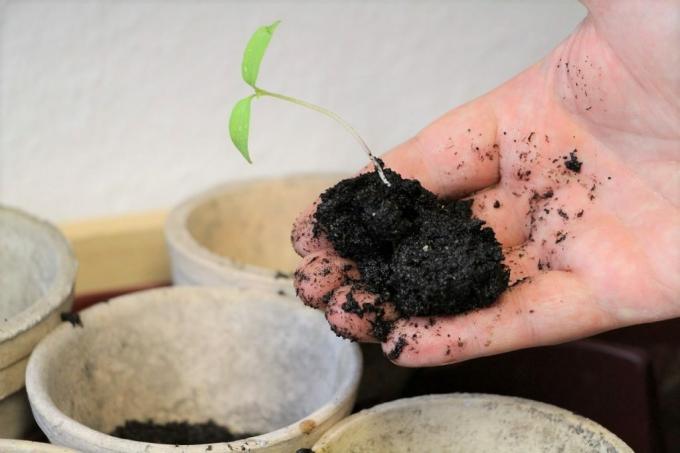
table of contents
- Optimal preparation
- Choose the ideal time
- Proceed cautiously
- Shorten the roots
- Fresh substrate
- frequently asked Questions
If the seedlings show up after sowing the various plants, you need to prick them out if they grow too close. The following article explains what the rules are like.
In a nutshell
- Pricking out means nothing else than to separate the seedlings and thus to offer more space
- after two to four weeks the first two cotyledons appear and ring in the time for pricking out
- It is only necessary to prick out if several seeds have been put into a seed pot
- if a seedling is pricked out, it receives fresh substrate that corresponds to the nutrient requirements of the plant
- The pricked plant is temporarily placed in a larger container until it is planted out
Optimal preparation
If it is necessary to prick out, then appropriate material is required in advance. Because the seedlings are very tender and could quickly be damaged during the process. Preparation before sowing is also important here:
- Use pricking or potting soil for seeds
- provide nutrient-rich soil for seedlings that have already been pricked out
- Potting soil contains no peat and few nutrients
- small pots up to about eight inches high
- small watering can with shower attachment
- allows careful watering
- Pricking stick
- alternatively coffee spoons or ice cream sticks

Note: You should never use tweezers when pricking. Because this could kink the stem or tear off roots in the earth, which would inevitably lead to the death of the seedlings.
Choose the ideal time
It is very important to pay attention to the right time when the seedlings should be pricked out. Because when the seedlings start to interfere with each other, it is often too late for a single plant to grow healthy and vigorously:
- about two to four weeks after sowing
- also depends on the type of plant
- each needs a different germination time
- as soon as the first two or three leaves show up
Tip: If the nursery pot with the seeds is warm, you can assume that a new leaf will grow back every week after germination. That is, three sheets in three weeks.
Proceed cautiously
If a seedling is pricked out, particular caution is required here, as the small plants are very tender and can be quickly damaged:
- Prick the soil next to the seedling with a spoon or prick stick
- deep enough
- Dig from below with roots upwards
- ideally do not touch it with your fingers
- Sheets could tear off
- Stems could break

Shorten the roots
If the seedlings were removed from the potting soil with a prick stick or a spoon, the roots should be slightly trimmed:
- choose only strong plants
- dispose of all others
- Carefully and easily remove soil from roots
- shorten roots here by about a third
- thus renewed root growth is stimulated
- The root ball becomes dense and strong
Fresh substrate
After germination in potting soil and pricking out, the seedlings should receive fresh substrate. This must contain the nutrients the plants need for healthy growth:
- Pay attention to the nutritional requirements of the individual plants
- choose suitable soil
- alternatively garden soil with compost Mix
- Use it to fill larger pots
- small, deep hole in the middle
- put one seedling each in a pot
- Depth of insertion depends on the type of plant

Tip: The small plants now remain in this pot until they can move to their previously selected location. This depends on the respective plant species and the prevailing climate. Plants that are to be cultivated in the vessel can be transferred into this immediately after pricking out.
frequently asked Questions
This is nothing more than separating the sown plants. If several seeds were placed in a nursery pot, the small plants will later take up space from each other. To prevent this, the plants are set apart, each given a larger pot with more space.
Whether vegetables, flowers or other plants. If several seeds were put together in a nursery pot to germinate here, then after a few weeks, when the first seedlings appear, you will not be able to avoid pricking.
If several seeds have been placed in one pot, it happens again and again that one or the other seedling does not get any bigger. Instead of pricking and moving these, you can remove them completely, because the resulting plants will remain stunted and, with useful plants, will not produce any yields.
This is actually very easy, but needs a little more space at the beginning, because you have to set up more seed pots for this. Then you can plant one or two seeds in each pot, assuming that only one of the seedlings will be strong enough here. The other, stunted, can then simply be removed.
The rules for this are that the potting soil is only suitable for the first three to four weeks. Because this has only a few nutrients, so that the roots of a seedling in search of them spread and grow quickly. After that, however, the seedling needs more nutrients to thrive. Therefore, all seedlings should be transferred to fresh, nutrient-rich substrate after about three to four weeks.



